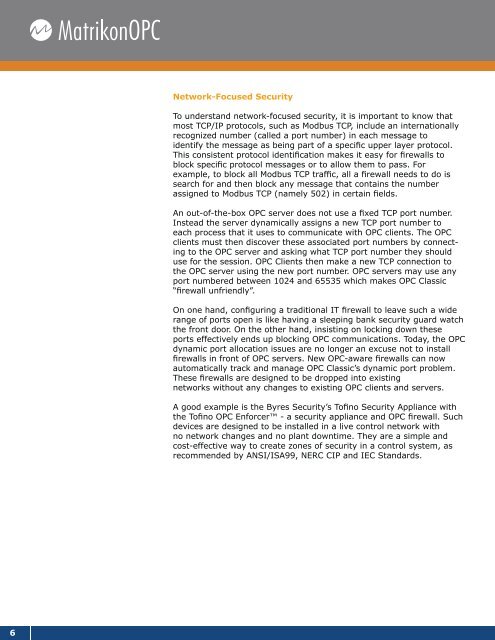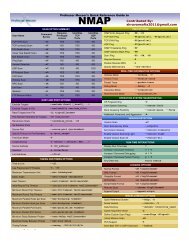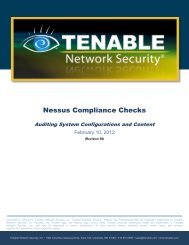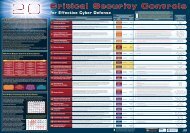Effective OPC Security for Control Systems - SCADAhacker
Effective OPC Security for Control Systems - SCADAhacker
Effective OPC Security for Control Systems - SCADAhacker
Create successful ePaper yourself
Turn your PDF publications into a flip-book with our unique Google optimized e-Paper software.
Network-Focused <strong>Security</strong>To understand network-focused security, it is important to know thatmost TCP/IP protocols, such as Modbus TCP, include an internationallyrecognized number (called a port number) in each message toidentify the message as being part of a specific upper layer protocol.This consistent protocol identification makes it easy <strong>for</strong> firewalls toblock specific protocol messages or to allow them to pass. Forexample, to block all Modbus TCP traffic, all a firewall needs to do issearch <strong>for</strong> and then block any message that contains the numberassigned to Modbus TCP (namely 502) in certain fields.An out-of-the-box <strong>OPC</strong> server does not use a fixed TCP port number.Instead the server dynamically assigns a new TCP port number toeach process that it uses to communicate with <strong>OPC</strong> clients. The <strong>OPC</strong>clients must then discover these associated port numbers by connectingto the <strong>OPC</strong> server and asking what TCP port number they shoulduse <strong>for</strong> the session. <strong>OPC</strong> Clients then make a new TCP connection tothe <strong>OPC</strong> server using the new port number. <strong>OPC</strong> servers may use anyport numbered between 1024 and 65535 which makes <strong>OPC</strong> Classic“firewall unfriendly”.On one hand, configuring a traditional IT firewall to leave such a widerange of ports open is like having a sleeping bank security guard watchthe front door. On the other hand, insisting on locking down theseports effectively ends up blocking <strong>OPC</strong> communications. Today, the <strong>OPC</strong>dynamic port allocation issues are no longer an excuse not to installfirewalls in front of <strong>OPC</strong> servers. New <strong>OPC</strong>-aware firewalls can nowautomatically track and manage <strong>OPC</strong> Classic’s dynamic port problem.These firewalls are designed to be dropped into existingnetworks without any changes to existing <strong>OPC</strong> clients and servers.A good example is the Byres <strong>Security</strong>’s Tofino <strong>Security</strong> Appliance withthe Tofino <strong>OPC</strong> En<strong>for</strong>cer - a security appliance and <strong>OPC</strong> firewall. Suchdevices are designed to be installed in a live control network withno network changes and no plant downtime. They are a simple andcost-effective way to create zones of security in a control system, asrecommended by ANSI/ISA99, NERC CIP and IEC Standards.6
















